Facebook Patent | Lightfield waveguide integrated eye tracking
Patent: Lightfield waveguide integrated eye tracking
Publication Number: 10168531
Publication Date: 2019-01-01
Applicants: Facebook

Abstract
An eye tracker for determining a position of an eye, which may be integrated into a head-mounted display. The eye tracker includes at least one waveguides with an array of grating structures, an array of light sources, a detector, and a controller. The controller activates at least one light source at a time to emit at least one light beam that propagates through the at least one waveguide and couple out via the array of grating structures towards a user’s eye. Light signals reflected from the user’s eye and skin surfaces are coupled into the at least one waveguide and propagate to the detector that captures the reflected light signals. The controller calculates magnitudes of the reflected light signals to obtain a signature of converted light signals, and determines a position and orientation of the user’s eye based on the signature of converted light signals.
Background
The present disclosure generally relates to eye tracking in virtual reality systems, and specifically relates to light-field waveguide integrated eye tracking.
For further development of artificial reality systems, eye tracking serves as a necessary technology advancement that can facilitate providing information related to user’s interaction and gaze direction. With efficient implementation of eye tracking, artificial reality systems can focus on aspects that are directly related to a visual experience of an end-user. Based on information related to a position and orientation of a user’s eye in an eye-box, a maximum pixel density (in a traditional display vernacular) may need to be provided only in a foveal region of the user’s gaze, while a lower pixel resolution can be used in other regions leading to savings in power consumption and computing cycles. The resolution of pixel density can be reduced in non-foveal regions either gradually or in a step-wise fashion (e.g., by over an order of magnitude per each step).
Integrating eye tracking into a small form-factor package that maintains stability and calibration can be often challenging. Traditionally, eye tracking architectures are based on an image formation through the use of a “hot mirror”, or by utilizing devices that work based on substantially similar methods. When the “hot mirror” approach is employed, an imaging device (camera) receives light that reflects off the “hot mirror” to image a user’s eye-box. The light was originally emitted by a (typically) infrared (IR) light source, e.g., IR light emitting diodes (LEDs) encircling the viewing optics. In the imaging approach, this provides a path for the camera to image the eye-box region of the device, which will allow one or more surfaces of a user’s eye to be imaged and correlated to a gaze direction. The image formed by the camera may identify various features of the eye, including light reflected by any visible surface, such as the anterior and posterior corneal surfaces, the pupil, the iris, the sclera, and eyebrows, eyelashes, and other facial features. Internal structures may also be observed by the camera, including reflections from the retina or the anterior or posterior crystalline lens surfaces. Eye tracking algorithms typically use a model-based approach, where these features are identified and used to refine the model parameters and, correspondingly, estimate the state of the eye, including its position and orientation with respect to a head-mounted display. In an alternative configuration, the hot-mirror can also be used in a non-imaging configuration, avoiding the need to process and use image(s) of the one or more surfaces of the user’s eye. This can be achieved, for example, based on correlating an eye-gaze coordinate with a maximized “red-eye” light signal, which is maximized around the foveal location due to the so-called “foveal reflex.”
However, implementing the hot-mirror based eye-tracking, whether imaging or non-imaging, into a small package that maintains stability and calibration is challenging. Therefore, more efficient methods for eye-tracking are desired for implementation in artificial reality systems.
Summary
Embodiments of the present disclosure support a waveguide based eye tracker for implementation in artificial reality systems. The presented waveguide-based eye tracker includes a plurality of grating structures, such as surface relief or holographic, one or more waveguides, an array of infra-red (IR) light sources, and a detector array. Each light source in the array of light sources can be a point source that emits light, and an array of point sources forms a light bar interfaced with the waveguide. The light emitted from each light source is coupled into the one or more waveguides and propagates through the one or more waveguides. The light can be out coupled from the one or more waveguides towards a user’s eye via one or more of the grating structures. Depending on an orientation of the user’s eye relative to the emitted IR light, some of the IR light is reflected back towards the one or more waveguides, which couples into the one or more waveguides and propagates to the detector array. Maximum reflection occurs when the eye (i.e., fovea) is looking directly at a location emitting the IR light. A controller coupled to the detector array captures the reflected signals of interest to determine a position and orientation of the eye and a position of the eye in an eye-box. The controller determines the position and orientation of the eye based on calculating relative signals measured from the incident IR light on the eye, which form an approximation to an illumination light field, in that the waveguide based eye tracker controls both position and angular extent of the illumination field across the eye-box.
In some embodiments, an eye tracker includes one or more waveguides, wherein each of the one or more waveguides comprises an array of grating structures, an array of light sources coupled to the one or more waveguides, a detector coupled to the one or more waveguides, and a controller, interfaced with the array of light sources and the detector. The controller activates one or more light sources at a time to emit one or more light beams that propagate through the one or more waveguides and couple out via the array of grating structures towards a user’s eye. Light signals reflected from the user’s eye and skin surfaces are coupled into the one or more waveguides and propagate to the detector that captures the reflected light signals. The controller calculates, based on the reflected light signals captured by the detector, magnitudes of the reflected light signals to obtain a signature of converted light signals. The controller determines a position and orientation of the user’s eye based on the signature of converted light signals.



